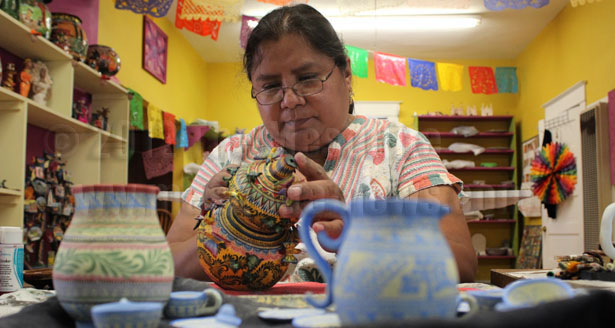
By Hilda Saavedra
Altars, bright flowers, colorful paper, candy skulls, skeleton figurines and family turn the sad occasion of losing a loved one into a celebration of the person’s life during Día de los Muertos or Day of the Dead.
Texas A&M-San Antonio assistant history Professor Amy M. Porter said Día de los Muertos is a celebration that has roots in ancient Aztec and other pre-Hispanic cultures from Mexico. The celebration was later incorporated into Catholicism by the Conquistadores, and throughout the centuries, the celebration has always been a joyous one.
“It is a celebration. It is a remembrance of those that passed,” Porter said.
In celebration, family members and friends gather to remember loved ones by constructing altars to honor them.
In Mexico, Día de los Muertos is more significant than Christmas, said Veronica Castillo Hernández, a local Mexican folk artist, who is based at MujerArtes Casita, a woman’s pottery cooperative on the West Side of San Antonio.
Castillo Hernández held a recent altar building workshop at Esperanza Peace and Justice Center, a community organization that works to preserve and promote artistic and cultural expressions of and among diverse communities, according to the website.
Altars should have a group of specific elements that are believed to help guide souls back to their families and friends, Castillo Hernández said. The items all have purpose in guiding the souls.
Each altar should contain a cross, water, salt, candles, incense, marigold flowers, a rug made of palm leaves, maize, pictures of the loved ones, candy skulls, food and bread of the dead, colorful paper banners and a floral arc, Castillo Hernández said.
“The altar is built at home, usually in the living room or some other spacious room in the house,” Castillo Hernández said.
In the south and central regions of Mexico, the festivities start as early as Sept. 30, but in the other regions of Mexico and in the United States, families start preparing around Oct. 27, with most of the festivities occurring on Nov. 2, Castillo Hernández said.
Many of the people attending the workshop were interested in learning about making altars for themselves; others were teachers that were looking to incorporate the celebration into their classrooms.
Castillo Hernández said people no longer celebrate Día de los Muertos out of devotion, and that it has become more of a custom or tradition that has lost some of its original essence. However, she said she does not have a problem with that, if it means conserving the tradition or custom.


